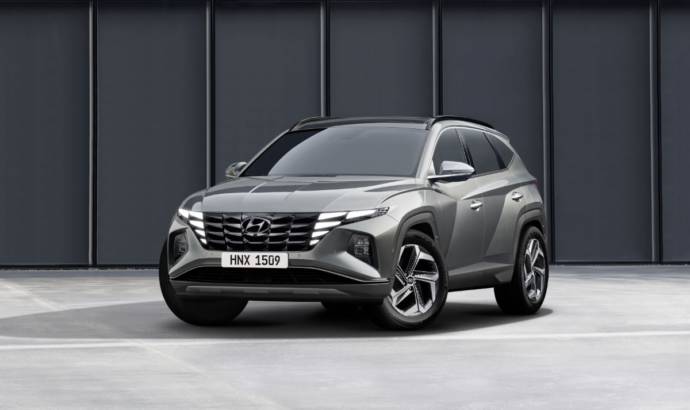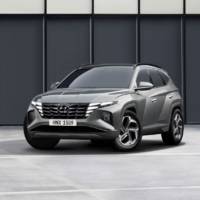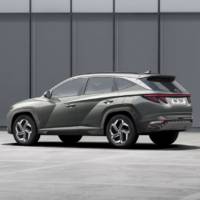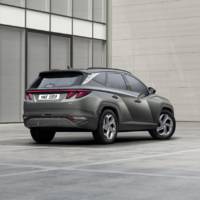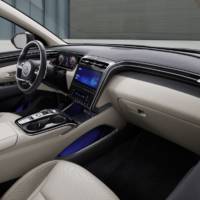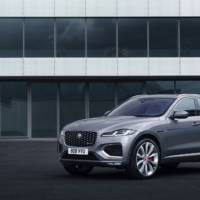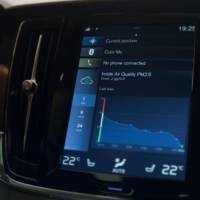After a long series of teasers, Hyundai finally unveiled the new generation Tucson, one of the most popular compact SUV’s in Europe and racking up global sales of more than 7 million units since its original launch in 2004.
The all-new Tucson goes on sale in Korea in September as a 2021 model. It will go on sale in the U.S. and other global markets as a 2022 model starting from the first half of 2021.
Tucson’s new exterior styling expresses Hyundai’s evolving Sensuous Sportiness design identity. The new SUV embodies what Hyundai designers call ‘parametric dynamics’ with kinetic jewel surface details.
The kinetic design theme carries over to the rear where the full-width taillamp incorporates half-hidden triangular shapes that are only visible when lit, echoing the DRL on the front. In order to achieve the purity of this design theme, the Hyundai logo moved up and is integrated into the glass while the wiper also moves up and hides under the rear spoiler.
Tucson gasoline models offer the following seven exterior colors: White Cream, Phantom Black, Shimmering Silver, Nocturne Gray, Amazon Gray, Flame Red, and Intense Blue, six of which are new for Tucson. Hybrid and plug-in hybrid models offer the following four colors: White Cream, Phantom Black, Shimmering Silver, and Intense Blue, three of which are new for Tucson. The SUV’s interior environments come in black or gray tones in either cloth or leather material.
The interior offers three new technologies, including a vertically stacked, dual 10.25-inch full-touch screen exempt of hard buttons, a multi-air ventilation system and an open, hoodless digital gauge cluster. These features create a high-tech, fresh and exciting ambience, with cushioned materials on high-touch areas, various material applications based on the frequency of interface and a premium presence. Tucson’s second-row seats will feature fold-and-dive functionality for optimized reconfiguration capability between passengers and cargo. Its cargo volume will provide an exceptional 38.7 cubic feet of usable space.
Tucson offers both Smartstream 2.5-liter, direct-injected, four-cylinder, gasoline powertrain and powerful 1.6-liter, turbo, direct-injected, hybrid or plug-in hybrid powertrains. The 2.5-liter engine has an estimated output of 190 PS and an estimated torque rating of 182 lb.-ft. This engine is coupled to an 8-speed automatic transmission for excellent efficiency and acceleration.
The 1.6-liter hybrid powertrain produces an estimated 180 PS, with a combined powertrain output of 230 PS. It also produces 195 lb.-ft. of torque from the gasoline engine and 258 lb.-ft. of torque from the combined hybrid powertrain. This new powertrain uses Continuously Variable Valve Duration (CVVD) technology that manages valve opening duration for optimal power, efficiency and emissions with minimized compromise.
Tucson was tuned to deliver agility and stability. Hyundai applied its first-in-class E-Handling technology for HEV and PHEV models to help improve steering response and directional stability when cornering or in adverse driving conditions. Tucson drivers get further assistance from Hyundai’s HTRAC all-wheel-drive system that provides sure footing on various road surfaces and conditions. While HTRAC previously supported Eco / Comfort / Smart / Sport driving modes, the latest version adds Mud, Sand and Snow in some markets.
Tucson’s full-touch display—home to navigation, air and infotainment controls—demonstrates how technology can be seamlessly integrated to provide an ergonomic and intuitive user interface, including convenient voice control. Tucson’s technology integration reaches its apex with the top-trim model’s 10.25-inch full-touch navigation screen. The navigation system offers split-screen functionality that enables multi-tasking capabilities, coupled with enhanced voice recognition.

